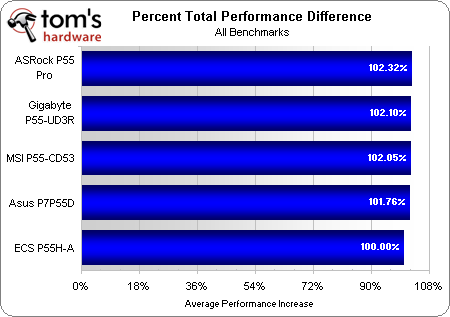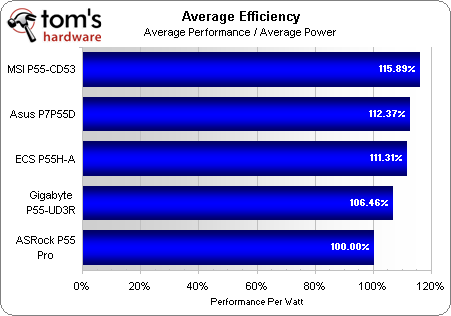P55 On A Budget: Five Core i5/i7 Motherboards For $100-$150
Conclusion
Gigabyte edged out Asus in CPU overclocking, but not by a lot. Meanwhile, Asus edged out Gigabyte in DRAM overclocking, but both reached data rates far exceeding anything useful for adding performance. A quick look at the average performance of each motherboard could help us determine the winner.
ASRock had the best overall performance, and the board might just be a good choice for non-overclockers. It's unfortunate for ASRock that we, and many of our readers, overclock. Of the two boards we can recommend, the Gigabyte P55-UD3R overtakes the Asus P7P55D in average performance. But we remember that Gigabyte also had higher average-power consumption, so how do these stack up in efficiency?
MSI wins the efficiency challenge, but once again without getting an overclocking endorsement. For that, we look to second-place efficiency-provider Asus.
None of us buy based solely on overclocking, one or two percent performance differences, or a few percentage points in efficiency. Rather, it’s the combination of overclocking, features, and performance that gets us ready to spend our money. For $10 more than the P55-UD3R, Asus’ P7P55D offers IEEE-1394 FireWire and slightly better overall efficiency. Gigabyte, on the other hand, offers a third SATA controller and supports Windows XP users with a floppy interface--all for $10 less. These two products are as close to perfectly-matched competitors as we’ve ever seen, so we’ll let you, the reader, make the call.
Get Tom's Hardware's best news and in-depth reviews, straight to your inbox.
-
dirtmountain The Asrock P55 Pro is 16x-4x, not 8x-8x.Reply
http://www.asrock.com/mb/overview.asp?Model=P55%20Pro
http://www.newegg.com/Product/Product.aspx?Item=N82E16813157171
The Asrock P55 Extreme at $140 offers 8x-8x -
JeanLuc Good read but it really just confirms what a lot of us have known for a long time. Don't buy budget motherboards (MSI, ASrock, ECS) if you want to overclock and it's no coincidence that the boards from Gigabyte and Asus passed with flying colours as these companies clearly have proper testing procedures in place and quality assurance measures to avoid such issues.Reply -
evongugg Another great article from Tom's, letting us know about how one of these motherboards can burn your CPU. Never would have known without you.Reply
Might have burnt out a CPU and not know the cause.
-
Crydee How would P55 stack up against non P55s is what I wanted to see as well. See if the premium is worth it over the more budget friendly P55.Reply -
avatar_raq Unfortunately neither Gigabbyte nor ASUS boards offer the 8x8x PCI-e slots for multiple GPUs. I think it's better to wait for their premium brethren to fall below $150 before upgrading.Reply -
SchizoFrog For the extra $20 you can get the ASUS P7P55D PRO which is a much better board and offers the full spec for multi GPUs... However, I personally can only recommend what I would do myself and that is to wait. There are a lot of major PC spec changes over the next 6 months. So I am waiting for USB3 and SATA3 to make it to mainstream.Reply -
SchizoFrog For the extra $20 you can get the ASUS P7P55D PRO which is a much better board and offers the full spec for multi GPUs... However, I personally can only recommend what I would do myself and that is to wait. There are a lot of major PC spec changes over the next 6 months. So I am waiting for USB3 and SATA3 to make it to mainstream.Reply -
helms I doubt their quality assurance is as good as you think Jeanluc. Both Gigabyte and Asus make crap DDR3 controllers for socket 775 motherboards. I've tested a heap of DDR3 socket 775 boards from Asus and Gigabyte, the Asus P5Q3 in particular is causing a lot of problems. When paired with a quad core cpu (everything stock) and running 3 threads prime(blend) + furmark, the system would inevitably freeze in under 2hr's (usually within the 30 minutes mark, quite a bit less than 2hrs). In fact systems with those boards would freeze even during normal non PC intensive use such as browsing the internet. Running prime+furmark just forces it happen rather than waiting for it to freeze which is quite random during light use like word prcoessing. I doubt Asus even realizes that their P5Q3 is a faulty product and shouldn't have hit retail stores. They have been selling the P5Q3 for ages. They probably tested the board with a cheap dual core celeron and since it worked with that called it a day.Reply -
burnley14 JeanlucGood read but it really just confirms what a lot of us have known for a long time. Don't buy budget motherboards (MSI, ASrock, ECS) if you want to overclock and it's no coincidence that the boards from Gigabyte and Asus passed with flying colours as these companies clearly have proper testing procedures in place and quality assurance measures to avoid such issues.Reply
I think you're jumping to conclusions here. Tom's reviewed some boards a while back for the 1366 socket and gave ASRock first place for quality and value.


